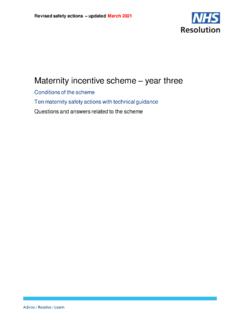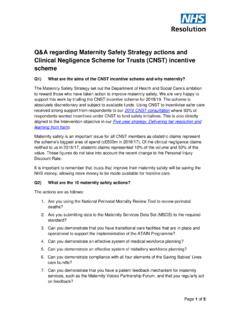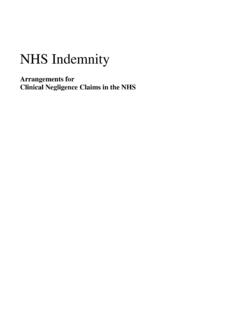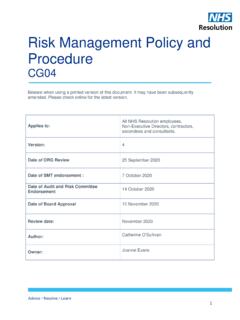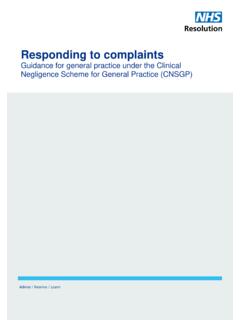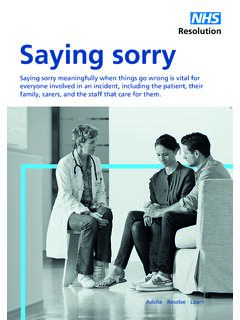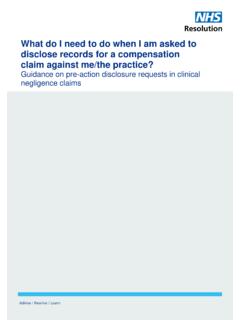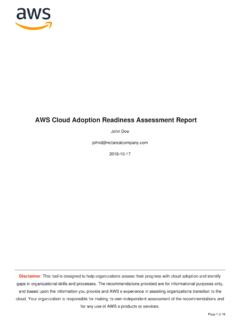Transcription of Our refreshed 2019 to 2022 strategic plan: Delivering fair ...
1 Our refreshed 2019 to 2022 strategic plan: Delivering fair resolution and learning from harm NHS Resolution Our refreshed 2019 to 2022 strategic plan Contents Contents Foreword 03 Overview 06 Who we are and what we do 07 A changing landscape 08 Our strategy at a glance 10 Our strategic priorities 11 What this means for us 16 Your feedback 17 Find out more 17 2 Foreword NHS Resolution Our refreshed 2019 to 2022
2 strategic plan Foreword Foreword Ian Dilks / Chair Our strategy to 2022: Delivering fair resolution and learning from harm published in April 2017 signalled a shift in direction, supported by a change in name to NHS Resolution. Since then, we have made considerable progress against our aims. Half-way through the period of this strategy, with so many changes to the environment we operate in, now is a good time to take stock of how far we have come, and where we are heading next. Much has happened in the last two and a half years. Signifcantly, NHS Resolution was tasked with Delivering a new indemnity scheme for general practice. This was not in contemplation when we set out our objectives in 2017. The move affords a tremendous opportunity to offer a responsive model of indemnity for new general practice claims - a model which adapts to the changing way healthcare is delivered.
3 We can also bring valuable data under one roof, providing a comprehensive view of the harm which results in compensation claims. This work builds on the foundations we already have in primary care through our Practitioner Performance Advice and Primary Care Appeals services. Helen Vernon / Chief Executive We are privileged to work in partnership with colleagues in health, to use our shared levers and information to best advantage to drive improvements in the system. These partnerships are increasingly important and valuable as our wider remit and strategic aims increasingly depend upon working in collaboration with others. Our maternity incentive scheme is an example of this where the arm s length bodies and royal colleges have joined with us to decide what actions are most likely to drive improvements in the safety of maternity services.
4 We are fnancially rewarding those trusts that can demonstrate they are taking these actions. Ultimately, we hope that this will reduce harm and claims. The new NHS patient safety strategy reinforces the beneft of building partnerships around shared objectives and for us, this means responding to the priorities of the health service and the changing landscape to add value. The NHS Patient Safety Strategy: Safer culture, safer systems, safer patients published by NHS England and NHS Improvement also features a section on clinical negligence and litigation costs. 4 NHS Resolution Our refreshed 2019 to 2022 strategic plan Forward Our strategic priorities are unchanged but we are refning how they can be achieved. We are convinced that our core strategic approach of where appropriate doing more, sooner - in the chain of events that lead to a claim, concern or dispute - is the right one.
5 Our research has emphasised the importance of improving the response to patients when something goes wrong, and this will become an area of heightened focus for us. We are gradually moving claims and concerns into a more neutral, less adversarial space. With our strategy refresh, we are keen to do more, to accelerate our efforts to keep matters out of formal processes where possible and to explore a range of methods to do so, with a greater emphasis on evaluation so that we know what works best and when. We have also recognised that we need to move faster to create useful information from the data we hold. Technology has moved on since we frst set out our intentions and with a new scheme in place, we will be putting more of our resources into technology and data analytics . This means getting expert advice on the choices we will need to make on where to invest so that we get the best possible solution at value for money for the NHS.
6 International interest in our work has grown signifcantly and we are keen to continue to learn from our international partners. We are therefore delighted to be hosting an international medical indemnity conference in 2020, which will help us to bring the very best of what works in this area to the UK. We will further develop our international links where this supports our purpose. We are a unique organisation supported by staff, who are genuinely committed to public service and doing the right thing for patients and the NHS. We will do everything we can to make sure that they have what they need to meet our objectives and continue to provide a fantastic service to those we work and engage with. 5 -Overview In April 2017 we published Our strategy to 2022: Delivering fair resolution and learning from harm which outlined our aims and objectives for a fve year period.
7 This update sets out our refreshed strategic priorities for the next two and a half years. This plan clarifes the choices we face as an organisation and provides some revised medium term priorities that are critical to our success. We have written it to engage with, and inform, our external stakeholders about our strategic direction. It also provides our staff with a clear shared view of our organisational goals to which everyone s work contributes. Our latest review of our progress is set out in our Annual report and accounts 2018/19 published on 11 July 2019. NHS Resolution Our refreshed 2019 to 2022 strategic plan Who we are and what we do Who we are and what we do Our purpose is to provide expertise to the NHS to resolve concerns fairly, share learning for improvement and preserve resources for patient care.
8 strategic aims Resolution Resolve concerns and disputes fairly. Intelligence Provide analysis and expert knowledge to drive improvement. Our services Claims Management Delivers expertise in handling both clinical and non-clinical claims through our indemnity schemes. Primary Care Appeals Offers an impartial tribunal service for the fair handling of primary care contracting disputes. Supported by Finance and Intervention Fit-for-purpose Deliver interventions Develop people, that improve safety relationships and and save money. infrastructure. Practitioner Performance Advice Provides advice, support and interventions in relation to concerns about the individual performance of doctors, dentists and pharmacists. Safety and Learning Supports the NHS to better understand their claims risk profles, to target their safety activity while sharing learning across the system.
9 Membership andIT and FacilitiesCorporate Planning Stakeholder Engagement Our values Professional Expert Ethical Respectful 7 NHS Resolution Our refreshed 2019 to 2022 strategic plan A changing landscape A changing landscape Working at the intersection between the healthcare and justice systems, we operate in a complex and evolving environment. This section sets out how the changing landscape continues to shape our strategic approach. Shaping the legal environment to address rising costs The cost of clinical negligence claims made against the NHS is rising at a faster rate than NHS funding, reducing the essential resources available for front line care. Payments in respect of clinical negligence claims in 2018/19 were billion, compared with billion in 2008/09.
10 However, due to the pay-as you-go funding arrangements for our indemnity schemes that allow funds to be spent on the delivery of care until they are needed, this fgure does not refect the true costs of clinical negligence incurred by trusts which will need to be paid in future years. Last year we estimated that the annual cost of harm at current prices was approximately 9 billion of which 60% related to maternity claims. As of the 31 March 2019, 83 billion would be required by the NHS to cover the estimated value of current clinical negligence claims and those claims where the incidents have already taken place, but not yet become a claim. Without changes to the way in which clinical negligence claims are compensated, costs will continue to increase. This is because we will be required to make payments in relation to incidents which have already occurred.
